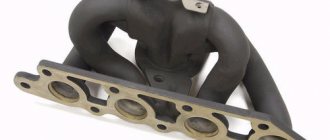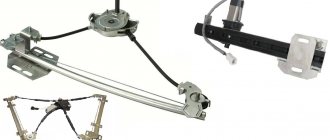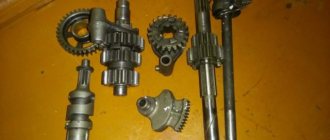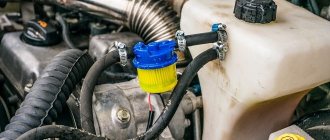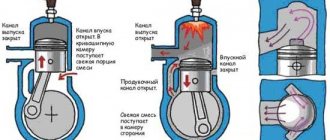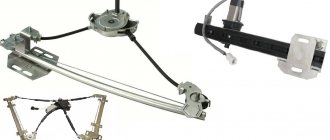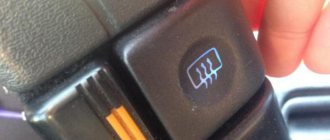What does the intake manifold do - the intake manifold directs air flow into the cylinder head, the amount of air is controlled by the throttle valve. Mixing of air with fuel usually occurs in a short part of the intake manifold or in the cylinder head, while the receiver serves to accumulate air and compensate for vibrations.
The choice of intake system is determined by the purpose of the car; on a tuning car it would be reasonable to use a sports receiver in series type with one throttle valve (Fig. 1), while on a sports car an intake manifold with one throttle valve for each cylinder, or a direct 4-throttle intake would be used collector (Fig. 3)
The "one valve per cylinder" arrangement (Fig. 2-3) gives lower pressure losses and is thus more suitable for achieving maximum power. However, if there is one damper, a clearer vacuum signal is created in the intake manifold. This greatly increases the precision with which fuel and ignition can be tuned at low speeds and thus makes the layout better suited to a road car. Synchronizing air flow between cylinders with a multi-throttle intake manifold is a completely different challenge. —————- ——————————- ——————————— —————-
Although the single choke system and the multi-choke system have two different purposes, they nevertheless have many common features. Both require ideally shaped openings for air inlet into the working passages to the combustion chambers. Both require careful consideration of design details, such as the taper of the working channels. Regardless of the purpose of the engine, it is desirable to accelerate the air on its way to the combustion chamber. Increasing the air flow speed, within reasonable limits, is beneficial because high speed provides high turbulence to the air-fuel mixture, thereby improving the combustion process. The filling of the combustion chamber is also improved, which provides more power.
In a symmetrical intake manifold (Fig. 4), the probability of equal distribution of flow to each cylinder is higher than in a more compact asymmetrical manifold (Fig. 5).
The length of the air passages significantly affects the amount of air that enters the cylinder during the intake cycle when the engine is running in naturally aspirated modes. Due to the complexity of this process, it is better studied separately from the turbocharger. Suffice it to say here that engines with higher operating speeds (over 2700 - 3000 rpm) require shorter and straighter intake pipes, and engines with low operating speeds and torque in the mid-range require longer intake pipes. In fuel injection systems, where only air passes inside the intake pipes (for example, mixture formation occurs in the cylinder head channels), the design of the pipes can be any.
Any engine manifold with a fuel injection system will have a receiver (unless a direct multi-throttle intake is used). The volume of the receiver should be a function of the engine displacement - in general, 50-70% of the engine volume. One of the important places in the design of the manifold is the intersection of the inlet pipes and the receiver. This intersection must be made in the form of a bell.
The sports receiver was developed and adapted exclusively for sports and later began to be used on standard devices. A standard engine with a factory receiver after 5000 rpm the engine literally dies from lack of air. Press or don't press on the pedal - the result is zero. There are a huge number of receivers: Stolnikov, SVR, 128, Bragin, Formash, STI (8 grade), Dynamics, Passik, Nuzhdin, Torgmash, Super-1600. The last two are covered in the military glory of circuit racing and rallies, and are the pinnacle of the structure of 16 cl receivers! And much depends on its volume in the operation of the engine.
Characteristic
So, what functions does the collector perform? The main task of this element is to uniformly distribute the fuel-air mixture or air (if it is an internal combustion engine with direct injection) among the cylinders of the power unit. Thanks to the uniform distribution of fuel, optimal performance of the internal combustion engine is ensured. In addition, one of the tasks assigned to the VAZ-2112 16-valve intake receiver is mounting the fuel injection equipment, as well as the throttle valve. If we talk about older cars, then a carburetor is attached to the manifold, which is involved in preparing the mixture.
We also note that the technology of turning off cylinders in order to save fuel on modern cars is achieved through the use of receivers with variable geometry. This function is often available on cars with V8 and V10 engines.
Another function is the operation of auxiliary systems. In the manifold, due to the downward pressure, a partial vacuum occurs. Engineers have learned to use vacuum as a driving force for:
- Brake booster.
- Cruise control systems.
- Emission control systems.
- Crankcase ventilation and so on.
The receiver in the car is
Receiver
(English receiver - receiver, from English receive - receive, accept, contain) - a technical vessel under pressure, can accept both liquid and gaseous media.
It is used as a storage device for storing compressed gas or liquid under pressure and for smoothing out gas pressure differences. For example, after compressor stations, receivers are installed as air collectors and serve to smooth out pressure pulsations after the pump, cool and create a reserve of compressed air, and remove oil droplets and moisture.
In steam engines, a receiver is a thermally insulated pipe connecting the high and low pressure cylinders [1].
Refrigerant receiver - a container for storing liquid refrigerant. Designed to collect liquid after the condenser to uniformly supply refrigerant to the evaporators and create a reserve of refrigerant in the system [2].
The engine is the basis of any car. This unit includes many components and mechanisms. One of these is the intake receiver (aka manifold). This element is available on every car. In today's article we will look at what an intake receiver is for, how it is designed and how it works.
Receiver materials and design
By its design, this element is a closed tank with outlet pipes and a common chamber. Just 15 years ago, aluminum and cast iron receivers were universally installed on cars. However, the situation changed in 2000. It was then that the first plastic manifolds began to appear on cars. A striking example of this is Ford cars with Duratek engines.
A riddle for our reader:
What will allow the piston driver to force more fuel mixture into the cylinder? Is the camshaft “humpbacked” or the crankshaft long-stroke?
Let's say 8th grade. camshaft with 11.2 lift (needs) or crankshaft 75.6mm instead of 71mm... the price of both spare parts is the same.
Let's say 8th grade. camshaft with lift 11.2 (STI) or crankshaft 78mm instead of 71mm.. The price of both spare parts is the same.
The rotor does not have a camshaft and I have not seen a long-stroke crankshaft. But I want to get more air in! The intake of the rotor is initially clamped, as is the exhaust... this article will convince you of this.
How it works?
Let's look at how the intake manifold receiver works. The fuel injectors or carburetor spray fuel into the receiver's downpipe. Due to electrostatic force, gasoline droplets will collect into larger ones in the air or settle on the walls. These actions are undesirable because they lead to incorrect mixture formation. The better the gasoline is atomized, the more completely and intensely it will burn in the chamber. Therefore, in order to eliminate negative factors and ensure the highest quality spraying, the internal parts of the receiver are made unpolished. At the same time, the surface is not excessively rough, since this can cause greater turbulence and lead to a drop in engine power.
The inlet receiver must have a certain shape, capacity and length. The best option is an equal-length collector. All of the above parameters are calculated when developing a specific power unit. The manifold ends with air channels that direct the flow of oxygen to the internal combustion engine valves. On diesel units with direct injection, the air flow swirls and enters the cylinder. In the latter, mixing with fuel already occurs.
Sports receiver. Breath! Do not breath.
Related links:
Intake tract parameters have a huge impact on the nature of power and torque changes. Due to the most correct determination of the pipeline size and intake settings, it is possible to achieve optimal filling of the cylinders than, for example, by improving the bends of the exhaust system pipeline
It would probably be stupid to completely modernize the exhaust system and completely forget about the intake. After all, the low-resistance filter we installed long before did not completely solve this problem. There is only one conclusion: we changed the exhaust system - we need to modernize the intake - install a sports receiver , otherwise there will be an inconsistency. The car does not breathe deeply, this feeling became aggravated after installing a direct-flow exhaust. It seems that the engine is permanently ill with chronic sinusitis. Nasal drops will not help, you need a high-quality inhaler. The sports receiver was developed and homologated exclusively for sports, and later began to be used on standard devices. Unlike the standard, the “pipes” of the pipes adjacent directly to the “can” have short, large channels that noticeably expand upon entering the huge hollow “cylinder” of the intake manifold. After all, the necessary result of this implantation is an increase in the amount of air supplied to the cylinders. After the throttle, the air enters the receiver, the volume of which significantly exceeds the serial one, and from there it is distributed among the cylinders through enlarged intake pipes of a certain length, which in turn change the direction of air flow by 90 degrees. A larger volume than the standard one makes it possible to smooth out air pulsations (after all, each cylinder is on the intake stroke only once out of four), and also in this geometry, the length of the intake tract is much shorter, which allows you to obtain additional torque at medium and high speeds. The sports receiver significantly improves acceleration dynamics at medium and especially high speeds; with it, up to 7000 rpm, the engine spins up quite quickly and with great pleasure. A standard motor with a factory receiver after 5000 rpm the motor literally “dies” from lack of air. Press - don't press on the accelerator pedal - the result is zero. With the sports receiver installed, it readily responds to the gas pedal pressed to the floor, it “breathes.” The car really drives. It’s not for nothing that doctors prescribe inhalations to sick patients.
VAZ 2112. engine 1500 16V. From the non-standard configuration only: 1. Sports receiver . 2. Zero resistance air filter with end air intake JR. 3. Modified ECU program ( chip tuning ).
Maximum power 114.3 hp/84.1 kw. at 6490 rpm. Torque 134.5 Nm. at 5520 rpm.
Please pay attention to the flat, horizontal torque characteristic from 3200 to 6200 rpm.
VAZ 2112. Sports receiver Sports receiver for 16V cylinder head Sports receiver for 16V cylinder head
Sports receiver for VAZ 8V. Cast. (unfortunately discontinued)
VAZ 2109. Sports receiver Sports receiver for 8V cylinder head Sports receiver for 8V cylinder head Sports receiver for 8V cylinder head Sports receiver for 8V cylinder head
Sports receiver for VAZ 16V. Cast.
VAZ 2112. Sports receiver VAZ 2112. Sports receiver Sports receiver for 16V cylinder head Sports receiver for 16V cylinder head Sports receiver for 16V cylinder head
Sports receivers "M-Power" for VAZ 16V and 8V. Cast.
Sports receiver for VAZ 8V Sports receiver for VAZ 16V Sports receiver for VAZ 16V Sports receivers for VAZ
Features of the shape and length of the receiver pipes
Recently, engineers have been paying special attention to these reservoir parameters. Sharp corners and sharp curvatures should be avoided in the channel design. In these places, fuel mixed with air will definitely settle on the walls. Therefore, most car manufacturers practice installing such receivers where all channels are of equal length, regardless of the distance from the center. This trend comes from sports cars.
This design eliminates the Helmholtz resonance. When the corresponding valve is opened, the flow of the mixture of air and gasoline moves clearly along the receiver channel towards the cylinder. When the valve closes, the air that did not have time to pass into the chamber continues to press on the plate. Under the influence of high pressure, the air tends to return to the upper part of the receiver. As a result, a countercurrent is formed in the channel. It stops the next time the valve opens. the change in direction of flow occurs at a very fast speed. Studies have shown that this speed is close to supersonic. Indeed, in addition to the closing and opening of valves, the air will tend to change direction due to the phenomenon of resonance. When air moves from side to side, it certainly leads to a loss of power.
Principle of operation
The principle of operation of the intake manifold is quite simple and consists in the formation and distribution of the air-fuel mixture. During operation, fuel and air enter it and are mixed in the flow. In this case, the technical characteristics of the mixture are important, which is monitored by a special sensor. It records temperature and pressure, and the control unit calculates the necessary data from this.
Based on the data obtained, the control of the injectors is adjusted. Subsequently, the mixture passes into the second sector of the manifold, where distribution is carried out among the cylinders.
The mixture enters the cylinders on the first stroke if the engine is running on a four-stroke process. It is sucked into the cylinders through the valves, after which the passage is blocked until the next first stroke. The intake manifold provides the required amount of air at the beginning of each stroke, which ensures efficient operation of the system.
For the intake manifold to function properly, it must have a strictly defined shape and capacity. These parameters are determined at the development stage so that it works effectively on all engines.
Collector pipe shape
Since precision must be maintained in the design, special attention is paid to the pipes. The channels must correspond to the exact parameters of length and shape; various curvatures and angles are not allowed in them. There are several reasons for this:
- fuel settling on the walls;
- Helmholtz resonance;
- calculation of pressure for system operation.
The first reason is simple, because fuel at sharp corners and protrusions will only settle on them. This can lead to blockages and narrowing of the channel in the future, so it is important to avoid such shortcomings.
The second reason is a common problem among designers. Helmholtz resonance is the resistance of air flow. When the intake valve opens, the mixture moves through the pipes to the cylinder. At the moment of its closure, the flow stops, but the inertia does not disappear.
As a result, the mixture presses on the valve, creating high pressure in this area. With the same pressure it is pushed back, creating resistance during the next intake. As a result, the technical characteristics of the collector are significantly deteriorated, and many elements are subject to increased wear.
The last reason is the calculation of pressure for the operation of the system. If the length of the pipes is too long, the system will have to compensate for the pressure in this area for normal fuel movement, which leads to additional wear on the system.
Intake manifold repair
Although the breakdown of this element occurs quite rarely, its repair is a headache for motorists. The reason for this is the ambiguity of diagnosing a breakdown, because often everyone blames the engine. Among the signs of collector failure it is worth noting:
- significant reduction in power;
- increased fuel consumption;
- arrhythmia of the system.
But in some cases there may be individual signs, which is important to consider. It is better to carry out comprehensive diagnostics at a car service center, which will give a more accurate result of the breakdown.
Often the valves in the manifold fail. In addition, the control valve may be damaged. If noise and crackling are observed in the system, then the reason for this is the disconnection of the tube from the swirler. However, it is worth understanding this after the fact.
When making repairs, you should first analyze the data from the manifold sensor. It will allow you to verify the breakdown of the element and even determine its cause. Next, you need to remove the device, which is done in several steps.
- The pressure in the system is reduced by turning off the fuel pump.
- The battery is disconnected and the decorative casing is removed.
- The air filter is removed.
- The throttle assembly is disconnected.
- The intake manifold itself is removed.
After which the actual repair of the device begins. It is important to note that some parts cannot be repaired. Among them, the flaps and control valve are especially problematic; if they break, you need to purchase a new part.
Often the sensor itself fails. If it does not work correctly, the control unit incorrectly calculates the parameters, which leads to poor formation of the air-fuel mixture. This must be taken into account, so if it breaks, it is important not to tighten it and replace the part, otherwise you may damage the engine. Quick troubleshooting applies to all intake manifold defects.
The repair is quite complicated; problems may arise when removing it and replacing certain elements. It is important to check all connections for insulation to avoid pressure leaks. It is also worth monitoring the valves so that they do not block the flow of the mixture.
Variable geometry receiver
This is a relatively new development that has recently received more and more supporters. Now there are several principles for implementing this design. One of them assumes the presence of two channels through which the mixture or oxygen can move. One channel is short, the other is long. Under a certain operating mode, the installed valve will close a short path.
Please note that when replacing the intake receiver, the gasket must always be new. If you install the old one, the seal will be broken. There is a possibility of air leaks and, as a result, unstable engine operation, as well as increased fuel appetite.
We will also consider the second principle of implementing variable reservoir geometry. Here the valve is mounted in the receiving pipe. When certain conditions are reached, the shutter will reduce the internal volume of the chamber. As a rule, this scheme is practiced on internal combustion engines with a small number of cylinders. On larger engines, more complex systems are implemented that also make it possible to turn off some of the cylinders in order to save fuel. Thus, the part of the chamber to which the channels of half the cylinders are connected is blocked by a damper.
2When is it necessary to drain condensate from the receiver?
As discussed above, as compressed air passes through the air collector, condensation invariably accumulates. Moisture forms on the inner walls of the receiver and flows to the bottom of the device. If water is not removed, build-up and corrosion will form, which will compromise the integrity of the structure and can cause the system to fail.
If the pneumatic network operates at full load, it is necessary to drain condensate at least once every 24 hours of operation, and even more often. To ensure normal operation of the equipment and achieve better results in removing condensate, it is recommended to install a float drain valve with a timer or an electronic valve.
Features of operation of the intake receiver
Unlike the engine itself, this part does not require maintenance. However, it is necessary to periodically monitor the quality of the gaskets. The slightest air leak causes the engine to trip and a yellow “Check” light on the instrument panel.
Note that plastic collectors, which are now widespread, are more susceptible to deformation than others. This point must be taken into account when tightening the receiver nuts. Be sure to use a torque wrench and observe the tightening torque. The bolts should be tightened from the center, and then move to the periphery.
Test No. 2
Acceleration was measured using a special Drag-On device. As a result of the races, a table of measurements was compiled on different configurations (the last measurement on the receiver was made on light forged wheels, all the rest on conventional stamping):
On the standard receiver, acceleration to 100 mph was 9.2 seconds, on the 21179 receiver - 9.1 seconds (different disks could affect the result). A noticeable difference is felt at a distance of 400 m. Receiver 21126 - 16.5 seconds, and on 21179 - 16.0 seconds.
About the modification of the collector
Tuning the VAZ intake receiver is a very popular topic. This operation has two directions. This is the refinement of the inner surface and overcoming the negative influence of the element’s shape. If the latter is asymmetrical, then most of the air will enter the first cylinder, and less and less oxygen will penetrate into all subsequent ones. But symmetrical also has disadvantages. Here the air will enter in the greatest quantity into the middle cylinders. Modifications to the VAZ-2114 intake receiver in this case consist of replacing the standard manifold with a multi-throttle intake system. Here the air flows no longer depend on each other. Accordingly, the same amount of oxygen enters each cylinder.
You can modify the intake receiver of the VAZ-2112 in another way. So, some grind the inner surface. By eliminating some of the highs and irregularities, you can ensure a more uniform air supply to the engine. But as practice shows, this modification does not bring a significant increase in power. A more effective solution is to install chokes. However, this should only be done when installing a turbine, otherwise tuning will not be justified.
Receivers for 8-valve engines
The Timeturbo store offers a wide range of receivers for 8-valve engines for all generations of VAZ and Lada cars with such engines. The catalog presents only high-quality components on favorable terms. We provide fast delivery to Tolyatti and throughout Russia. The main purpose of a car’s intake system is to fill the cylinders with the air-fuel mixture. The better quality it is made, the better filling you can achieve. The system consists of an intake receiver (manifold), a throttle valve, a filter and a multi-throttle intake. Receivers are responsible for filling the cylinders. The behavior of the engine greatly depends on their volume, shape and configuration. Standard receivers are designed for maximum performance in the low and mid ranges, so their use in tuning would be inappropriate. The main advantages of the improved manifold: • better filling of the cylinders; • increased acceleration dynamics; • increased vehicle power. Our website has a convenient and functional electronic catalog for the selection of components, which greatly facilitates the search. In addition, our managers provide qualified assistance in selecting parts. To receive it, just call 8 800-2228-163 or leave a request on the website.
Functionality of AV receivers
Signal Boost
Since an AV receiver is still a multi-channel amplifier, its most important function is signal amplification. How does this happen? An audio signal is received from the player, TV or other source connected to the receiver. If it is digital, then the receiver first converts it to “analogue” and then amplifies it to increase the volume or adjust the level of frequencies (high, mid, low). And then, with the help of a power amplifier, the receiver helps achieve rich bass and rich sound at low frequencies.
Video switching
Video signal switching is a function that any receiver must perform. Its task is to combine all video signals coming from several sources (for example, DVD player, PC, TV) into one, which allows you to free your room from a web of wires and easily manage all available video sources.
Audio Decoding
All modern DVDs and Blu-Ray discs have multi-channel recording, that is, each speaker has its own audio track with a certain content and volume. The parameters of each audio track are recorded on the disc in the form of codes. To get exactly the sound that is recorded on the disc, the receiver must correctly decode the information, and for this it is equipped with special decoders. The more encoding formats your receiver accepts, the more different discs you can play.
Modern AV receivers
work with Dolby Digital and DTS formats. To play Blu-ray and HD DVD discs, the receiver must support the new “high definition” formats - Dolby Digital Plus, Dolby TrueHD, DTS-HD Master Audio and uncompressed PCM signal.
DSP Modes
Some AV receiver models have a DSP digital audio processing system. Such AV receivers are capable of giving the sound special effects - like being present in a stadium or in a temple. If you like such experiments with sound, provide such a function in your receiver.
Multiroom
The presence of a multiroom function means that the receiver can “sound” several rooms in your house at once. How does this happen? Using a special button, two additional amplifiers from the receiver are simply switched to the next room. Moreover, depending on the receiver model, not only the audio signal, but also the video signal can be redirected to the next room.
Automatic sound adjustment
Many modern receivers are equipped with an auto-calibration function, or automatic adjustment of sound parameters. To do this, a control microphone is included with the AV receiver, which allows you to configure all sound channels taking into account the size of the speakers, the distance to them, the acoustic characteristics of your room, ceiling height, area and other listening conditions. The main goal of such adjustment is to adjust the optimal sound volume, time delays in different channels and create the most comfortable sound tonality.
Video “enhancement” functions
Some receivers have an upscaling feature that can be used to convert video to a higher quality format (for example, from PAL to HD). High-end models additionally allow you to adjust sharpness, resolution, color balance and brightness for individual sources. The latest generation receivers increase resolution up to the latest 4K format, which “fits” four times as many pixels as Full HD. But this function is only available if the TV or projector supports this format.
Video conversion
Thanks to the built-in video converter, various signals are converted into the same type (for example, composite to component or all analog to digital HDMI). This means that you can connect a player, PC, video camera or game console to the AV receiver using a single cable.
Control with one remote control
In high-end receiver models there is a learning remote control function. This means that all devices connected to the receiver can be controlled using one remote control.
AV Receiver Control
Controlling the receiver consists of two components - the initial installation of all settings and direct adjustments during use.
How wide the receiver's control capabilities will be depends on the class and cost of the selected model. The higher these parameters are, the “smarter” and more thoughtful the control system is.
In general, you can control the receiver in the following ways:
- using buttons on the device itself;
- using a remote control;
- through the web interface of the device and a computer connected to the local network;
- using special installation programs and a computer via a local network;
- through iPhones, iPads and similar Android devices.
The most common and accessible way to control the receiver remains the remote control. Often the buttons on it are divided into several groups for ease of use, and the remote control itself is universal and suitable for controlling various devices connected to the receiver.
The web interface control option is more suitable for those who spend a lot of time at the computer, for example, processing music and simultaneously playing it on home speakers.
The most modern and convenient option, perhaps, is to control the receiver using mobile devices.
If you have been familiar with smartphones and tablets for a long time, you will probably like the “mobile” method of controlling the receiver. To enable this feature, you need to download the corresponding application from the manufacturer’s website, AppStore or Google Play, install it on your tablet computer or smartphone - and the mobile device will turn into a touch remote control for the receiver. Such applications are free, but only work with gadgets from the corresponding manufacturer.
High-quality applications allow you not only to use the main remote control buttons, but also provide many additional features such as adjusting the sound in the second zone, convenient navigation on the Internet, setting an auto-shutdown timer, and even wirelessly downloading music. However, in order to use all the additional features, your receiver and smartphone must be connected to the same network - do not forget to check this point.
You can test how a specific application works without connecting to the network - just select demo mode.
Keep in mind that full-scale control of all sound and picture functions is possible only from new models of receivers, and only top receivers allow you to download music libraries.
To avoid any unpleasant surprises, before purchasing a receiver, make sure that the device has remote control applications that are compatible with tablets or smartphones running iOS or Android, depending on what mobile device you use.
Controlling the receiver using the touch screen is attractive due to its clarity and dynamic adjustment to any situation. In addition, a smartphone is a gadget that is always with you, and the risk that you will lose it is almost zero. The same cannot be said about remote controls.
The only inconvenience of controlling the receiver using a smartphone is that the mobile phone must first be switched to remote control mode. But compared to the other advantages of this control option, you can turn a blind eye to such a minor disadvantage.
Input and output interfaces
The back wall of the receiver can scare any inexperienced user - after all, there are so many connectors of different shapes and diameters that it’s easy to get confused. In practice, a large number of input and output interfaces means that you can connect even the most outdated device models to the receiver.
Here is a standard list of interfaces that an AV receiver should have.
Sound Interfaces
RCA
– analog stereo sound is connected through this connector. Often an interface is needed to connect an audio recorder or CD player.
S/PDIF
– an interface through which audio data is transmitted in digital format. This interface can be of two types - coaxial with RCA connectors and optical with TOSLINK connectors. The second transmits a signal of higher quality, since it is reliably protected from external influences such as magnetic fields that can affect the quality of the signal.
Interfaces for video transmission
A/V (RCA composite video)
- This is the most “ancient” of all interfaces for transmitting analog video signals. It is present, perhaps, on any TV, set-top box, or camera. The interface consists of three connectors, one of which transmits video, and the other two transmit audio. The RCA interface cannot provide high signal quality and image clarity.
S-Video
– this type of connector may be needed to connect game consoles or DVD players. The interface provides good signal quality, clearer and more colorful images compared to composite video. Keep in mind that using S-Video you can only connect a picture; sound is connected through other interfaces.
SCART
– through this interface you can connect to the receiver a TV and other equipment equipped with a similar connector for transmitting audio and video. This interface can support stereo audio, S-Video, RGB.
Component interface
– this connector allows you to transmit high-definition signals with a resolution of up to 1080i, particularly suitable for HDTV transmission. To connect equipment to the receiver via a “component”, it must have appropriate outputs, and the TV or projector must have component inputs.
Among analog signal transmission methods, component is the most advanced and provides the best quality when broadcasting analog images.
HDMI
- This is not only a modern, but also the most universal type of digital connection, which simultaneously transmits high-definition video and multi-channel audio. To connect a receiver with such an interface to a TV or projector, you only need one cable of the appropriate type. Today, every modern receiver is equipped with several HDMI connectors for connecting several devices simultaneously.
Digression and explanation
What is the difference between an end inlet and a radial inlet? The 415th automobile rotor has a fuel mixture supplied through cast iron sealing covers. In 416th and 426th rotary motors, the feed goes through the stator. The last two were used in motorsports and light aviation
(left 415 stator, right 416e)
(inside view of the stator, radial in the background)
(on the left is the 415th stator, on the right is the 415th converted into a radial one)
(both engines are radial, fuel supply is through the stator)
(view from the inside of the converted end cap for a radial. The window is blanked out)
(end package, feed through lids)
(from the diagram everything is clear what and how)
Converting a face motor into a radial motor requires significant (albeit simple) interventions. This can be said not as tuning, but as boosting engine power! There are enough articles on the site dedicated to radial rotary motors.
Receiver software
Even if you buy an ultra-modern receiver with the latest generation software, this does not mean that after a year, or maybe a few months, this “firmware” will still be relevant. Manufacturers and programmers regularly refine and improve the firmware of receivers so that they ensure the best performance of the device.
These updates can usually be found on the Internet, on the manufacturer's website, on special portals, or in the menu of the device itself. They can be downloaded from a computer, a regular flash drive, another receiver with new firmware, from the Internet or from a satellite.
Why change the receiver's firmware at all? What does this give?
Updating the software will help get rid of freezes and other malfunctions in the receiver. The device will start working faster, will accurately execute commands and respond to the remote control. Perhaps new channels will appear in the updated firmware, new functions will begin to work, the receiver will be able to read media files from external media, go online to watch the weather forecast or videos on YouTube. Fans of high-quality sound will appreciate the special firmware for 3D sound.
As you can see, updating the software can improve the performance of the receiver, which means do not forget to reflash your device from time to time. The main thing is to be careful and choose software specifically for your receiver model. Incorrectly selected firmware can damage your receiver so badly that you will have to buy a new one.
Types of equipment
Compressor receivers can be vertical or horizontal. Containers of the first type are more in demand because they are compact in size and allow rational use of the production area.
Equipment examples
- Model: RV900 10 bar
- Capacity: l/min
- RUB 85,157
- Model: RV500.2 16 bar
- Capacity: l/min
- RUB 44,331
- Model: RV 110/10
- Capacity: l/min
- RUB 20,800
All models
All air collectors, regardless of configuration, can be easily combined into a common network if necessary. Moreover, installation can be performed in two methods - parallel and sequential. Each method has its pros and cons.
Equipment examples
- Model: RV900 10 bar
- Capacity: l/min
- RUB 85,157
- Model: RV500.2 16 bar
- Capacity: l/min
- RUB 44,331
- Model: RV 110/10
- Capacity: l/min
- RUB 20,800
All models
Parallel connection
The advantage of this installation method is the high maintainability of the system. If one of the receivers fails, it is simply disconnected from the overall system and repaired or replaced. In addition, this method provides maximum storage throughput.
Serial connection
The main advantage of this installation option is the additional cleaning of the working environment from moisture and oil impurities. Compressed air sequentially passes through all containers in the network and is cleaned along the way. As for the disadvantages of such a connection, they include the total resistance of the receivers, which reduces their throughput.
